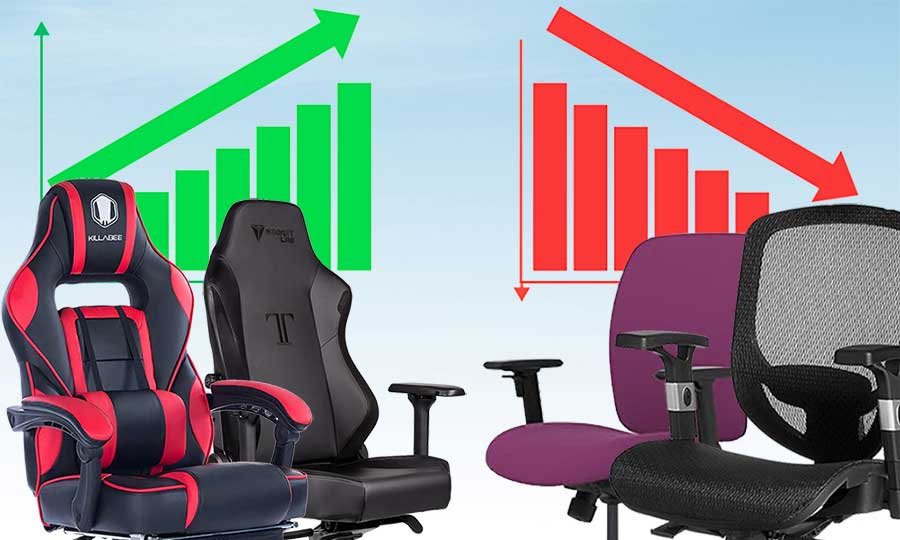Ergonomic science seeks to fit a workplace to a user’s needs. In the 1800s, mandatory schooling + the Industrial Revolution made standard office chairs ubiquitous. In the 90s, PC computing + Internet brought ergonomic chairs to the fore. Fast-forward to 2023: a multi-faceted, multi-device ergonomic shift is upon us. Here’s a timeline of ergonomic evolutions from 1850 to 2023.
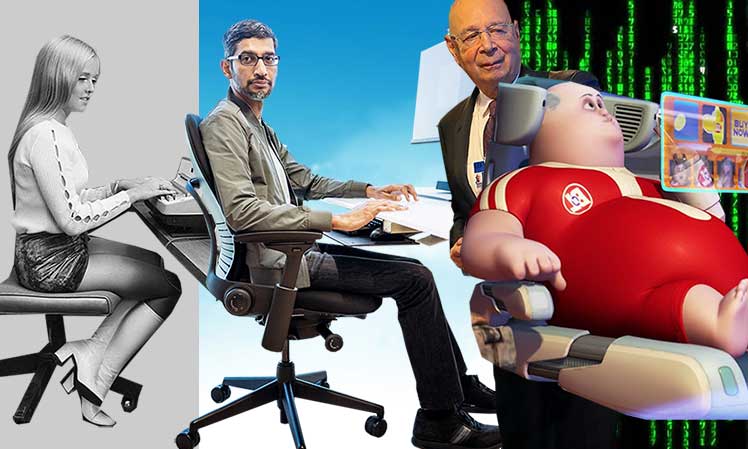
The human body is not designed to sit for long periods. For 180,000+ years, fitness was driven by the need to survive. Hunting, gathering, and defense made people lean and fit(1).

In America, the shift from agricultural to industrial life brought major lifestyle changes:
- Primitive Nomads (pre-10,000 B.C.): very high levels of fitness. Tribes often went on 1 to 2-day hunting/ gathering journeys. After successful excursions, groups would travel 6-20 miles to visit other tribes.
- American Colonial Period (1700-1776): high levels of fitness. Life revolved around plowing wilderness, hunting for food, and herding cattle.
- American Post-Civil War (1865-1900): low levels of fitness. Industrial life replaced an agricultural one as people transitioned to sedentary city living.
The industrial era created a massive demand for full-time sitting support. Standard office chairs filled that role. Early models only let you adjust the seat height.

By the 1970s, padded seats and rocking functions emerged as the pinnacle of luxury. Then, personal computing + Internet sparked an ergonomic seating revolution in the 1990s.

Significantly, the importance of crisp, 90s-era postures is fading. In its place, a new, semi-formal sitting style is taking root.
Ergonomic History Timeline 1850-2023
- 1850: Mandatory Schooling. As formerly active farm kids began sitting full-time, chronic back problems emerged.
- 1904: First Adjustable Desk Chair. Frank Lloyd Wright designed an office chair with a height-adjustable seat.
- 1965: Adaptive seat padding. Recaro develops adaptive foam car seats.
- 1972: NASA Discovers Neutral Postures NASA scientists discover healthy sitting biomechanics while observing astronauts aboard the Skylab Space Station.
- 1976: Padded Office Chair. Herman Miller’s Ergon chair adds foam and padded arms to a height-adjustable seat.
- 1980: Documented Neutral Posture Biomechanics. NASA documents its neutral posture findings for other industries to use.
- 1990s: Personal Computing + Internet. Rising sedentary times skyrockets lower back pain problems worldwide.
- 1994: First Fully-Ergonomic Chair. Herman Miller fuses NASA’s neutral posture tech into the Aeron desk chair.
- 1999: Second Fully-Ergonomic Chair. Steelcase responds to the Aeron with the Leap chair.
- 2005: Neutral Posture Car Seats. Nissan fuses NASA’s neutral posture tech into ergonomic car seats.
- 2006: First Full-Back Gaming Chair. Car seat maker DXRacer borrows Nissan’s car seat tech to create full-back, racing-style gaming chairs.
- 2008: First Computing Chair. Herman Miller’s Embody was released as a more versatile ‘computing’ chair.
- 2013: Steelcase Gesture. Steelcase releases its own ‘computing’ chair.
- 2013-2020: Desktop Computing Ergonomic Science Stalls. NASA’s neutral posture concepts (adjustable lumbar + arms + recline) don’t develop any further.
- 2021: Multi-Device Ergonomics. The Handbook of Human Factors and Ergonomics hypes multi-device support as the new ergonomic priority.
- 2022: Esports Hypes Fitness Over Chairs. Top docs tout frequent breaks and healthy lifestyles as better performance boosters than good sitting posture.
- 2022: Herman Miller Vantum Abandons Good Posture. Herman Miller’s Vantum decrees perfect sitting posture outdated – relaxed postures better fit these times.
- 2023: Seating Priorities Go Beyond The Cubicle. Neutral posture, mobile support, psychological appeal, and user discipline form take over as the ergonomic priorities of our time.
1850: Mandatory School = Back Problems
The earliest American schools (1600s era) taught about family, religion, and community. Academic subjects emerged around 1850. Then, schools had summer and winter seasons.

Girls went to school in the summer while boys worked the fields. In winter, the girls would stay home to help with the chores. This compromise worked well at keeping kids active.
The first compulsory school attendance laws were passed in 1852 (Massachusetts). By 1900, attendance became compulsory in thirty-two states. Critics argued that this would force kids to distort their bodies by sitting at desks for 6 hours every day.
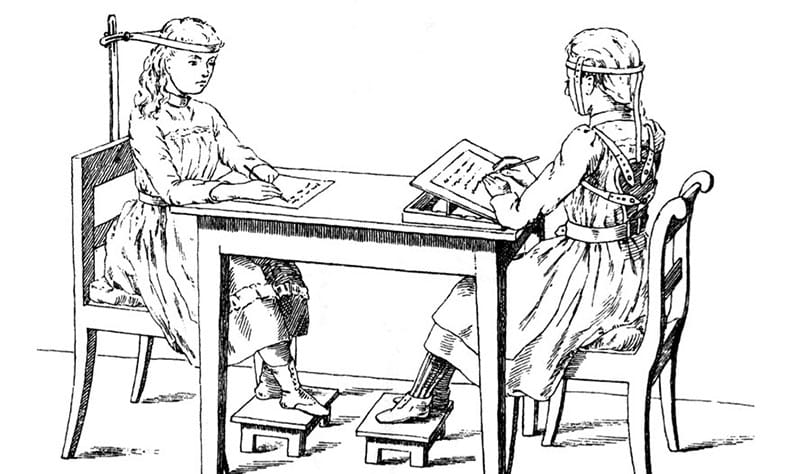
Indeed, in 1890, a leading pediatric journal raised an alarm. It found that more than 50% of American kids were suffering from deformed spines(2). To address that, a national obsession with ramrod-straight postures emerged.
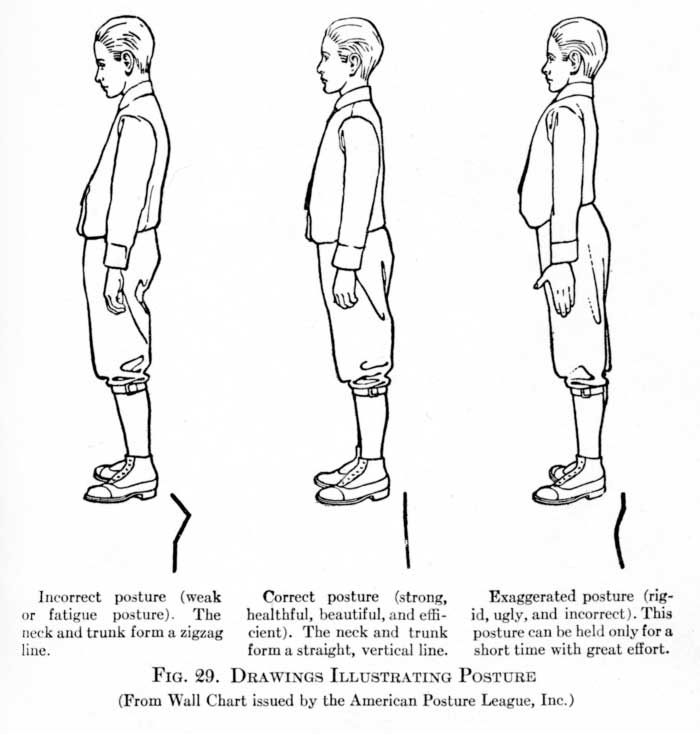
That proved to be brutal for both schoolkids — and early deskbound office workers. For more on ergonomic evolution in academia, see this:
1904: First ‘Ergonomic’ Chair Concept
Office life in the early 1900s was brutal. For instance, these 1894 secretaries had to sit in stiff wooden chairs all day(3). With no ergonomic support, they would have to flex their back muscles all day long to hold themselves upright.
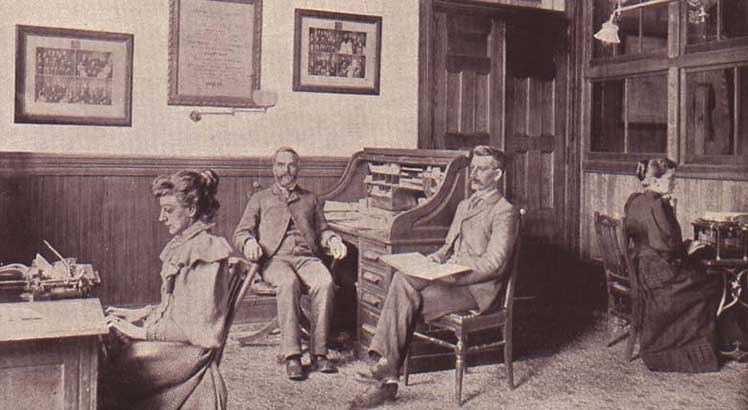
To make sure they kept sitting ramrod straight, two goons watch over them to ‘manage’ their work.
Frank Lloyd Wright’s Office Chair
Many point to Frank Lloyd Wright’s 1904 design as the world’s first ergonomic chair. This torture rack ignored comfort and other human factors. Its groundbreaking feature was a seat height adjustment mechanism. The point of that was to architecturally align people.
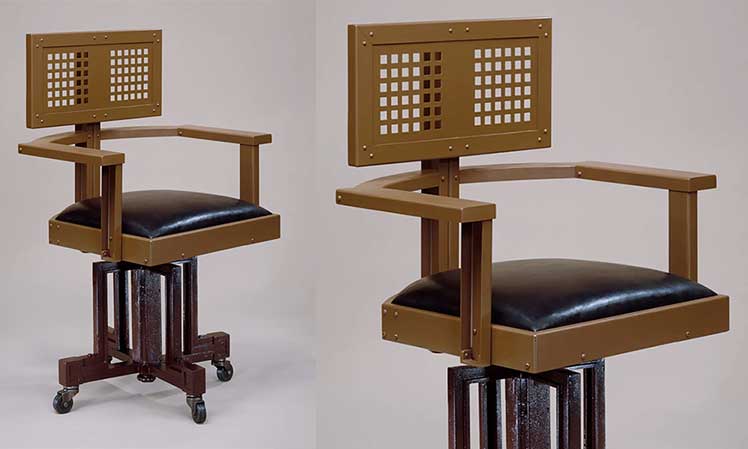
Wright even designed a less comfortable 3-legged version for secretaries. It was so uncomfortable that many users called it the ‘suicide chair’.(4)
1965: RECARO Foam Car Seats
For the next 90 or so years, most office workers only needed to shuffle papers and push pencils. As a result, the office chair scene was stagnant for most of this time.
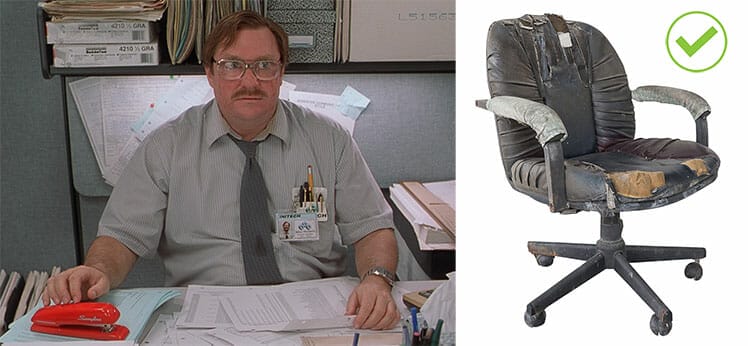
Comfort and other human factors weren’t a priority. A good chair for the typical ham and egger needed only to be cheap and strong.
Car Seat Ergonomic Innovations
Pencil-pushing office workers were well-served with cheap steel chairs. However, a growing automobile market created a need for more comfortable car seats. In 1965, the Recaro Sportsitz made its debut at the International Motor Show (IAA) in Frankfurt.
Most car seats of that era used metal springs in the seat core and horsehair padding(5). The innovative aspect of the Sportsitz was its foam padding. Compared to horsehair on springs, its shock absorption delivered a much smoother ride.

The RECARO team went on to develop several ergonomic seating staples. Here are some of their most notable achievements(6) over the years:
- 1965: the RECARO sports seat introduced foam padding and side bolster concepts.
- 1968: world’s first seat with a headrest + adjustable shoulder support.
- 1973: headrests became standard on all RECARO seats.
- 1977: pneumatic lumbar support introduced.
- 1989: the world’s first sports seat with a hard-shell plastic back.
In the early 1990s, Recaro worked with scientists, physicians, designers, and engineers. They developed Recaro DNA guidelines with the idea that form follows human needs. Today, all Recaro seats (including its new gaming chairs) follow these guidelines.
1973: NASA Discovers Neutral Postures
In 1973, NASA launched Skylab, its first space station. Photos were taken of astronauts as they relaxed in space. Researchers noticed that they typically fell into neutral postures(7).
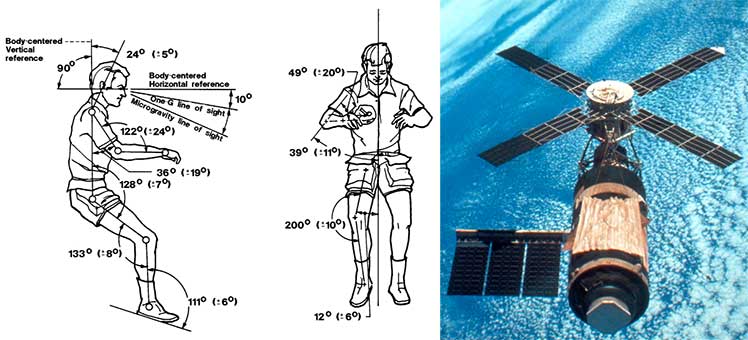
Neutral body postures reduce the body’s need to support itself against gravity’s pull. That offloads musculoskeletal stress, reducing pressure on the spine.
1976: Herman Miller’s First Chair
Nine years after RECARO brought molded foam to car seats, Herman Miller did the same for office chairs. In the early 1970s, Bill Stumpf joined the Herman Miller Research Corporation. There, he earned financial support to develop a new type of chair.
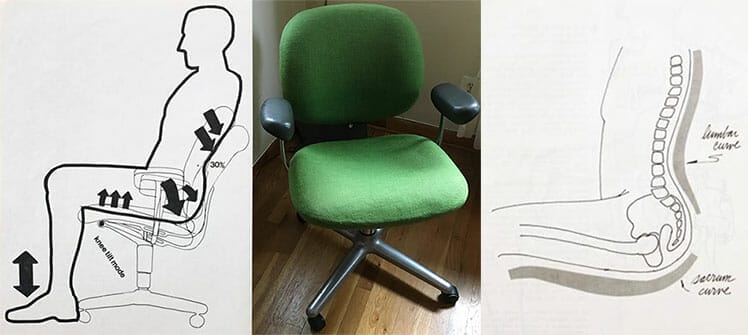
His Ergon concept book proposed the world’s first chair designed with ergonomic performance as a criterion(8). Among his comfort criteria were these points:
- Design: comfort is as much a matter of mind as of the body. A good chair tends to telegraph its comfort.
- Foam padding: rigid chair shells and frames defeat the natural dynamics of the body at work. A live chair shell better supports active postures.
- Lumbar support: the chair should support the convex lumbar curve between the buttocks.
- Distributive seat: sitting in a chair places 50% of body weight onto two bones in the buttocks. A well-padded seat can distribute this load across the entire seat pan.
- Functional armrests: sitting cross-legged places tremendous weight on decorative armrests. A good chair should have solid armrests with generous padding.
In 1976, Herman Miller Ergon released the Ergon for retail sale. It lacked the height-adjustability of Frank Lloyd Wright’s 1904 edition. The ‘ergonomic’ (adjustable) quality was its adaptive foam.
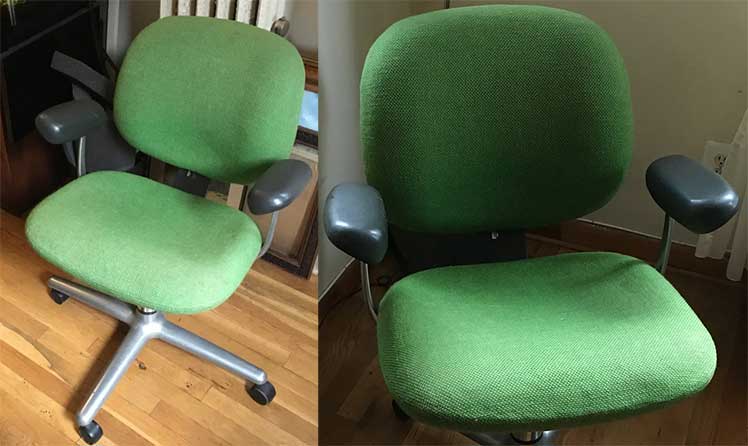
It was designed to adapt to the shape of the user’s buttocks. At the same time, it would provide enough firmness to keep the user stable. Stumpf’s comfort criteria for that chair have influenced the design of every Herman Miller chair design since then.
Today, the complete list has evolved to include 22 salient points.
1980s: NASA Documents Neutral Postures
By the 1980s, NASA had documented NBP into the Man-Systems Integration Standards (MSIS) NASA-STD-3000. It outlined ways to encourage neutral body postures in support of human health, safety, and productivity.

Within a decade, ergonomists had ported over these findings into healthy desk worker sitting parameters. In sum, to support neutral postures, users need a chair with three essential adjustable features.

Planted feet, a supported lumbar curve, supported arms, and a customizable recline support a 25-45° lower back curve while sitting.
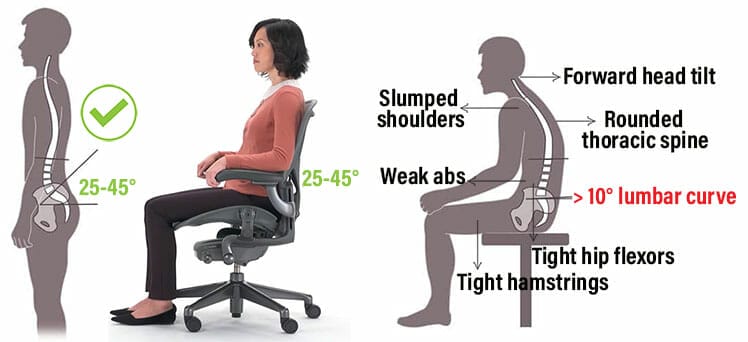
With that support, users are able to sit for long periods without suffering musculoskeletal stress. But despite these findings, standard office chairs continued to reign — until sedentary sitting times skyrocketed in the 1990s.
1990s: Personal Computing Arrives
In 1985, Microsoft released its Windows 1.0 operating system. Six years later, the Internet went live for the world. Then, sedentary time spent computing skyrocketed(9).
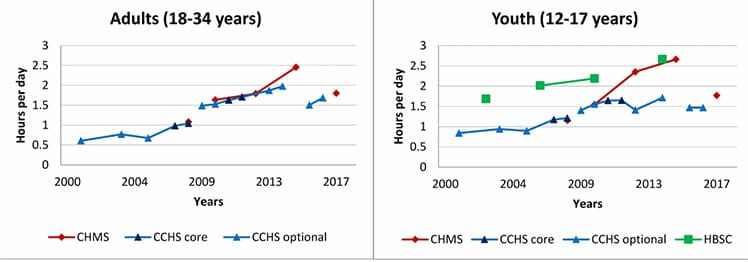
That triggered a rise in global health problems. First, the prevalence of lower back pain incidents surged(10). Childhood obesity levels also started trending upwards in the 1990s.

Mapping active vs sedentary trends out over time also looks bleak. For example, University of North Carolina researchers looked at data collected since the 1960s on activity habits. Then, they projected those trends to 2030.

In brief, increasing time spent engaged in sedentary behaviors places more stress on the spine. But the wheels of commerce don’t take kindly to rest breaks.
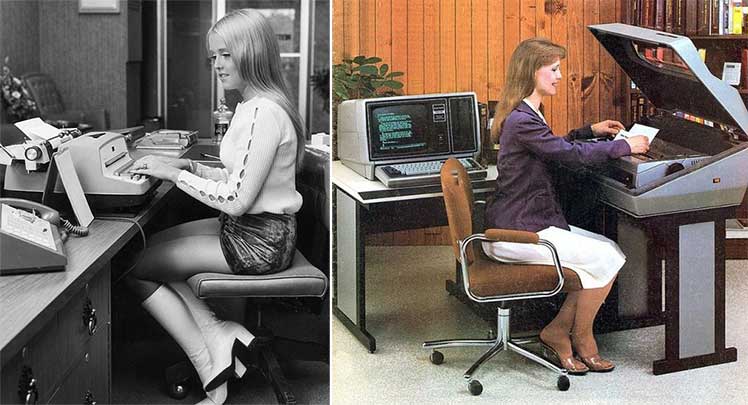
Instead, the time was ripe to re-invent the desk chair using NASA’s neutral posture findings.
1994: Herman Miller Aeron
As personal computers became ubiquitous, it was clear that a new type of seating was needed. Herman Miller asked Don Chadwick and Bill Stumpf to design a good office chair for the times.
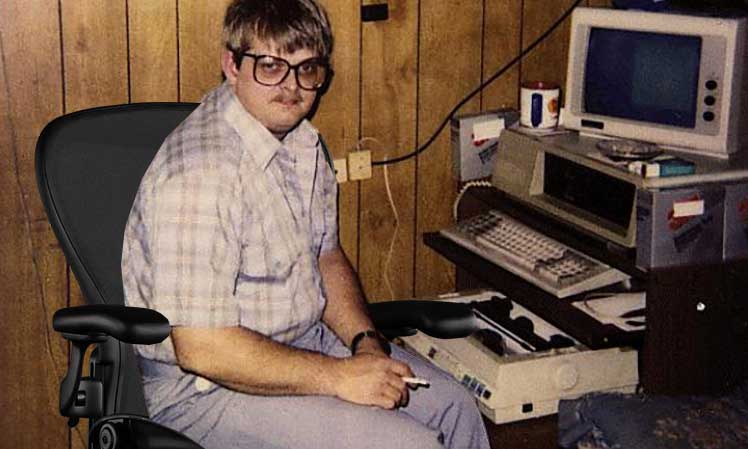
They set themselves some design criteria. The ideal 1990s chair should:
- Move and adjust in a simple, natural way.
- Support the back even when users fail to take movement breaks.
- Support a person in any position, for any type of task.
- Blend in well with office environments.
In 1994, Herman Miller released the Aeron chair. It broke new ground in several ways. First, it came in three sizes to suit 95% of body types. Second, the designers had recently developed a chair mesh that prevented bedsores.
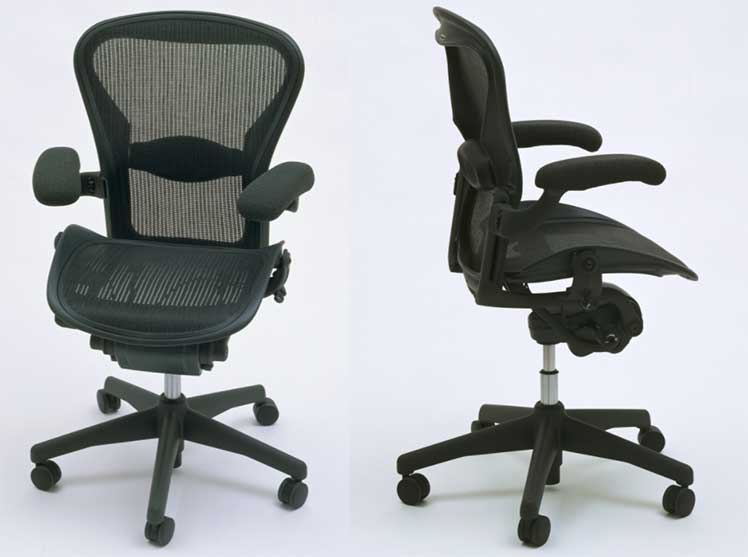
On the Aeron, this became Pellicle Mesh. This breathable material could flex in various directions with a sleek, elegant look. Third, the Aeron took inspiration from NASA’s findings with a Kinemat tilt. Key features:
- Adjustable lumbar support
- Adjustable back tilt, forward tilt, and seat height
- 2D armrests with soft caps
- Infinite recline (lock in any position between 93-104°
- 10-year warranty
This sophisticated tilt mechanism mimics natural human motion. That lets the body pivot at the ankles, knees, and hips, mimicking in one synced motion. Compare the original vs the updated version:
1999: Steelcase Leap
In 1999, Steelcase hopped aboard the ergonomic bandwagon with its own version of the Aeron. Both utilize a lumbar-powered support system with adjustable arms.
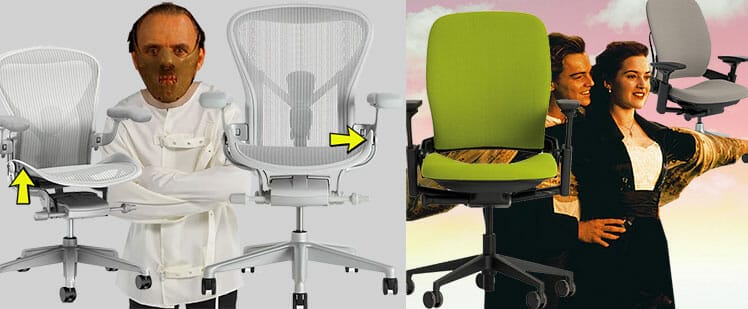
Instead of mesh, the Leap countered with a padded fabric seat and backrest. In contrast to the Aeron’s bladed seat edges, the Leap’s milder edges are roomy enough to sit cross-legged.
2005: Car Seats For Neutral Postures
A 2001 recession has crippled the American manufacturing sector. Over that decade, America lost 33% of its manufacturing jobs. The auto industry was in shambles.

In 2005, with little to lose, scientists at Nissan Motor Company used NASA’s MSIS research to develop ergonomic car seats. Like astronauts, car drivers must feel comfortable while operating a vehicle efficiently for long periods. However, a person’s posture appeared to play a role in how tired they became while driving.
To reduce driver exhaustion, Nissan developed a prototype to support the spine in its natural position. Based on NASA’s NBP studies, it was designed to reduce muscular loading on a driver’s back, pelvis, and torso.

In 2006, Nissan published the results of its study. It confirmed that its prototype seat supported the spine from the pelvis to the head and improved blood flow.
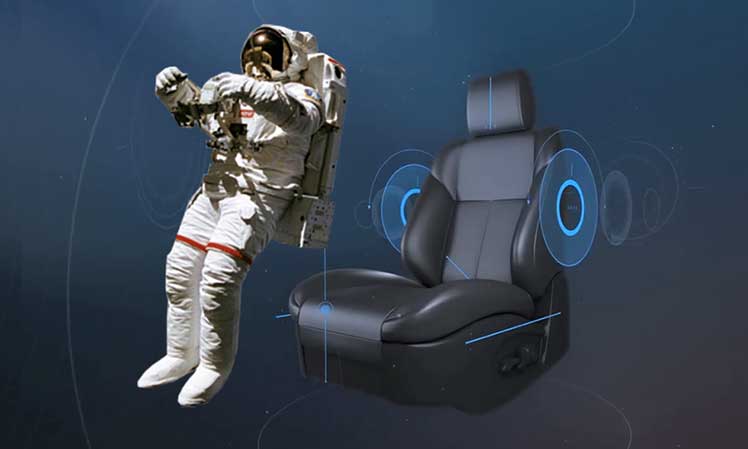
The driver was able to maintain a near-perfect NBP in the experimental seat. That significantly reduced fatigue over long periods of sitting(11).
2006: World’s First Gaming Chair
The same year that Nissan published its findings, DXRacer released the world’s first gaming chair. At the time, they were an exotic car seat company struggling in the recession.
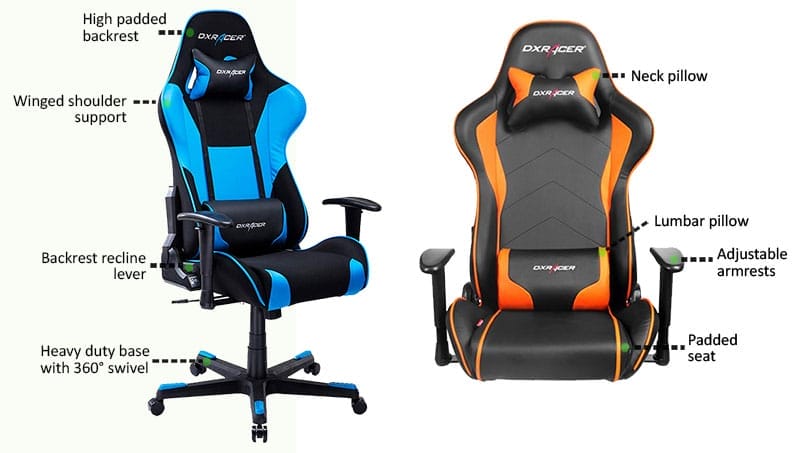
Like Nissan’s prototype, the DXRacer Formula Series was also designed to reduce fatigue over long sitting periods. It borrowed several ergonomic innovations from the past:
- RECARO-style molded foam seat and backrest (1965).
- NASA-style neutral sitting consideration.
- Herman Miller Aeron-style adjustable lumbar and armrests.
- Nissan-style backrest support.
Around the time of this release, a perfect storm of events rocketed gaming chairs to stardom:
- A global recession drove many jobless South Korean youth to video game arcades.
- Gameplay became so intense that Korean TV stations started broadcasting tournaments. That was the birth of the global esports industry.
- Most gamers spent long periods sitting but could not afford a $1000 Aeron chair. Gaming chairs filled this gap.
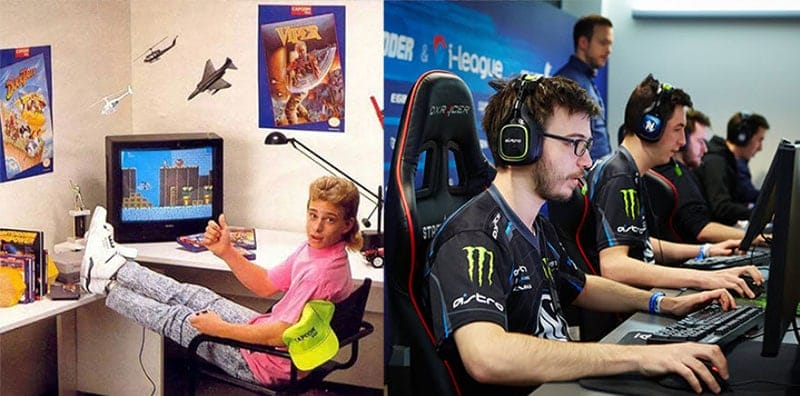
For the full story covering 2006-2022, see this feature:
2008: Herman Miller Embody
In 2008, the rise of gaming chairs — and mobile computing — drew a response from the mega-corporations. Then, Herman Miller released the Embody. While the Aeron provided lumbar-powered sitting support, the Embody prioritized support to the upper spine.
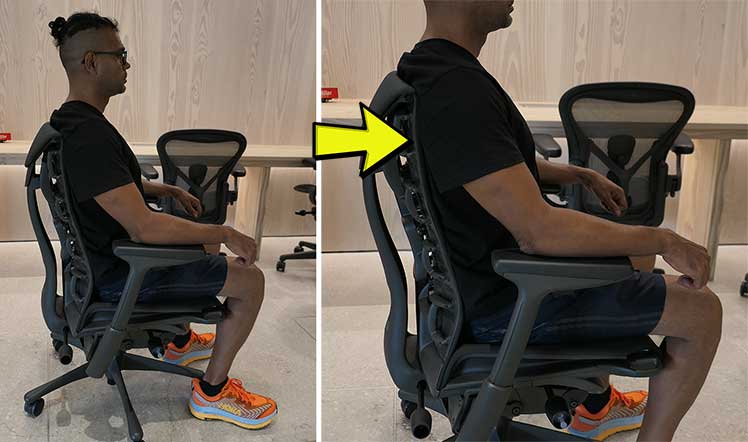
Instead of lumbar support, its Backfit system lets you angle the built-in upper back curve until it cups the upper spine. It works spectacularly well. However, it’s a complex technology not easily replicated.
2013: Steelcase Gesture
Five years after the Embody’s release, Steelcase replied with its own ‘computing’ chair called the Gesture. Significantly, instead of trying to reimagine the Embody’s concept, it copied the Aeron’s traditional lumbar-powered support style.
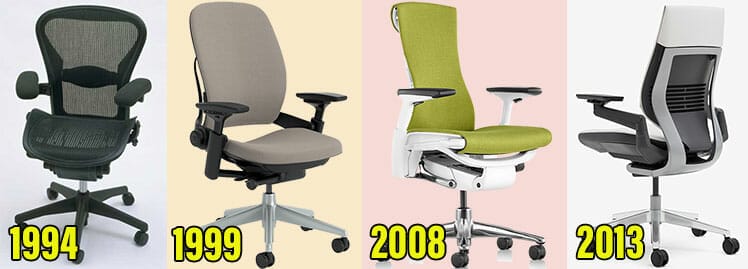
Every clone chair that followed did the same. All of them shunned the Embody’s upper back support style for a more easily-replicated lumbar-powered support style.

Also significant was the Gesture’s 360° rotating armrests hyped to support mobile computing. These boast an industry-leading armrest range that extends 11.5″ above the seat.
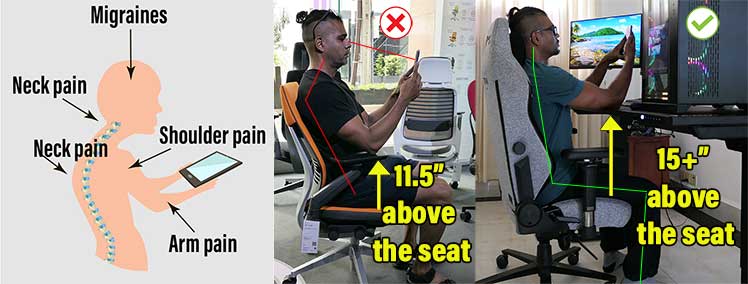
Notably, by modern standards, the Gesture’s mobile support is exaggerated. As the industry-leading mobile support chair, that means no ergo office chairs properly support mobile computing.
In 2023, regardless of your chair, you’ll need to add a height-adjustable desk for proper mobile computing support.
Back Support Innovations Peak
Our timeline shows that major seating innovations happen in sync with socio-technological change. But since 1994, the formula has remained the same: adjustable lumbar + arms + reclining backrest = neutral posture support.
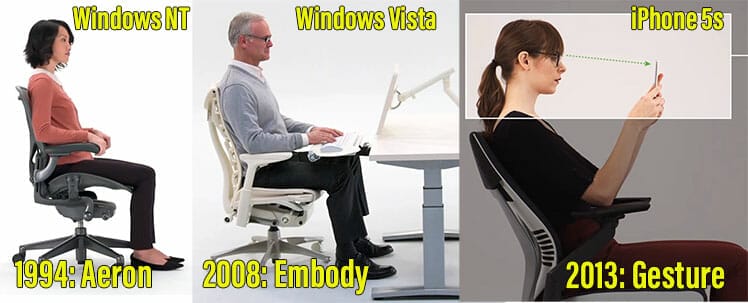
Since then, most innovations have been cosmetic. Herman Miller’s Embody stands out with a fancy, mega-flexible backrest. The Gesture does similar with flashy, 360° mobile-compliant arms.
But no significant innovations have followed. Instead, chair makers have kept an illusion of freshness with variations of the same adjustable lumbar + arms and recline basics.
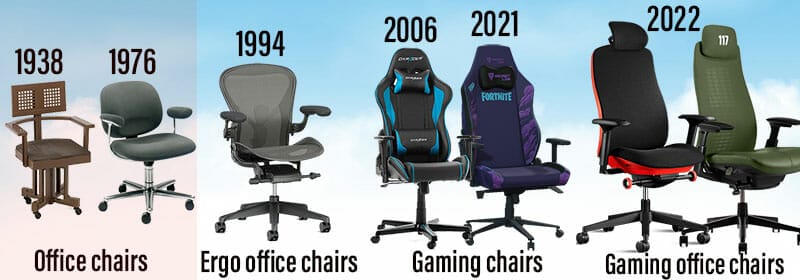
In fact, circa 2023, leading office chair companies are ‘innovating’ by going backward — borrowing from 2006-era gaming chair tech!

Modern-day ‘gaming office’ chairs like the Respawn Flexx (pictured) and Herman Miller Vantum reimagine old-school gaming chair concepts. These package full-back neutral posture support + deep recline functionality) with flashy mega-corporate aesthetics.
2021: Multi-device Ergonomic Guidelines
For years, WEF policy-makers have been hyping a 4th Industrial Revolution. This aims to plug the masses into a near-virtual reality powered by an Internet of Things (IoT).
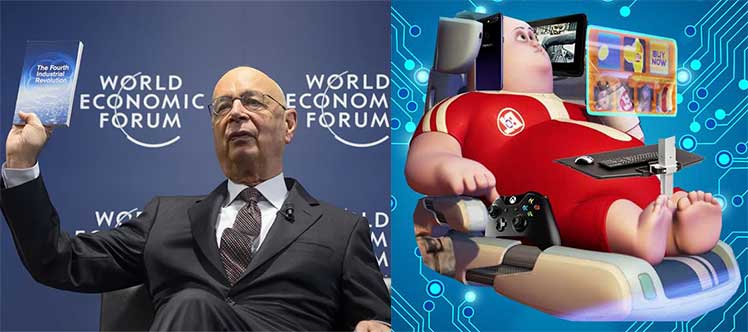
Meanwhile, the Handbook of Human Factors and Ergonomics (HFE) has been documenting workplace design standards since 1994. The point is to furnish productive workspaces that customers enjoy using.
In late 2021, it released a major 5th-edition update that supports the 4th Industrial Revolution vision. It cites two major technostress problems needing solutions:
- Musculoskeletal technostress: excessive desktop computing stresses the lower back; Mobile computing causes text neck (bent neck and rounded upper spine). In a multi-device workplace, both must be addressed concurrently.
- Mental technostress: humans are not equipped to handle constant flows of digital information. Techno-addiction (inability to unplug), depression, and mental burnout are common problems needing solutions.
2021: Esports Optimization: Fitness > Chairs
As chairmakers focused on aesthetics, pro esports optimization specialists took the lead on healthy sitting tactics. But rather than hyping ergonomic chairs, many tout frequent movement breaks and healthy lifestyles as greater performance-boosting priorities.
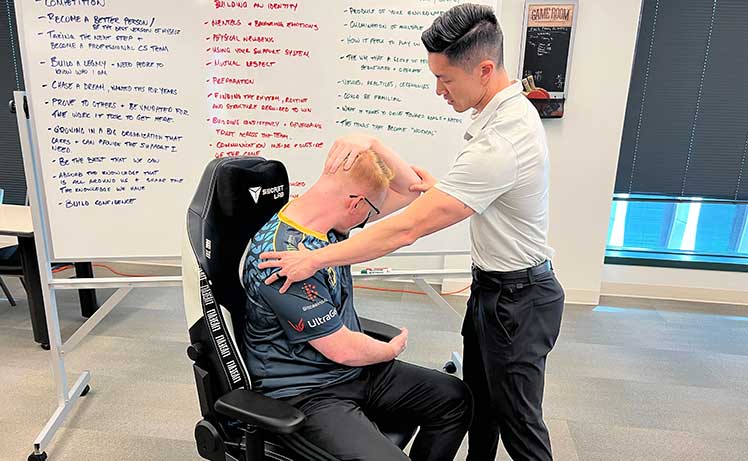
For example, Dr. Jordan Tsai currently does performance optimization work with Evil Geniuses. He thinks that having a good chair is helpful, but not essential:
Many top esports teams and indie streamers follow a similar philosophy. For one thing, most notables use some type of ergonomic chair.
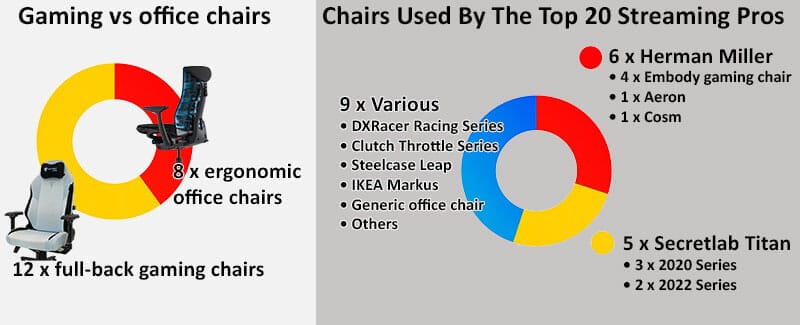
For another, most also incorporate physical fitness and healthy lifestyles as an essential part of their routines.
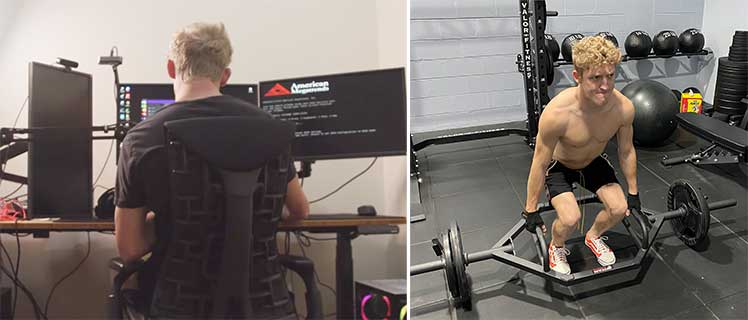
Then, per top esports docs, you don’t even need to sit with perfect posture. Instead, take frequent breaks, do stretches, get exercise, and eat clean.

In theory, doing so will override potential harm caused by sitting with less-than-perfect postures.
2022 Deskwork Priorities: Fitness + Posture Beats Technostress
2022: Herman Miller Vantum Flexi-Posture
Most modern esports doctors don’t emphasize the need to sit with perfect posture. In sharp contrast, Herman Miller’s flagship Embody and Aeron chairs are specifically designed to support sharp neutral postures.
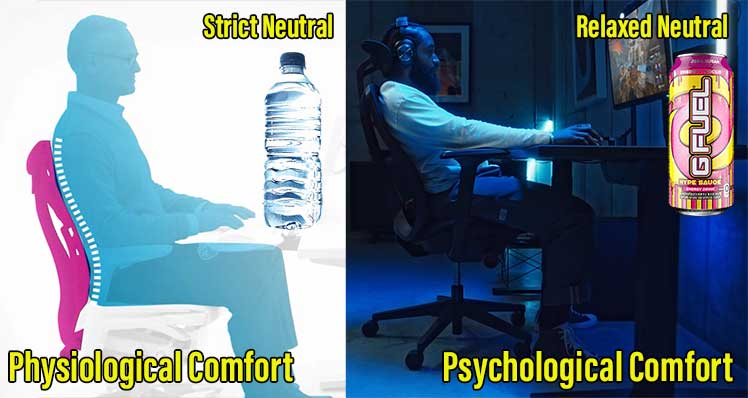
But in 2022, the company’s Vantum gaming chair served up a radical change in ergonomic philosophies. In hyping the release, Herman Miller Gaming GM Jon Campbell declared:
Curiously, in its zest to hype its new gaming chair, Herman Miller throws its existing line of chairs under the bus! According to GM Jon Campbell, sitting in strict neutral postures is now ‘bad’.
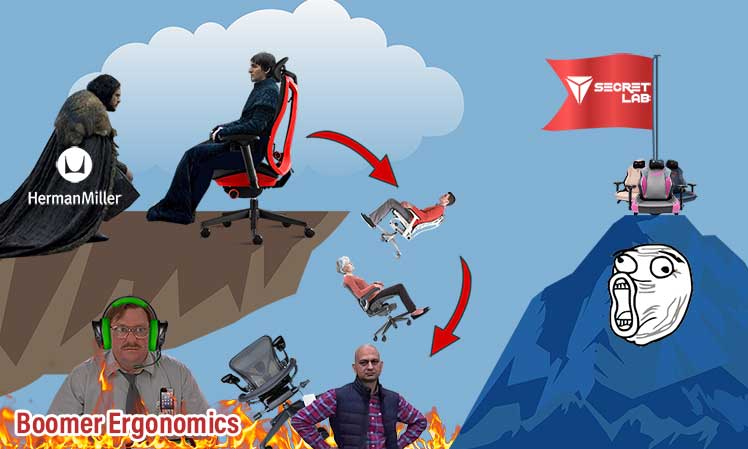
Meanwhile, sitting hunched over with a forward-leaning posture and splayed legs is now ‘good’. This leaves existing Aeron, Embody, Sayle, and Mirra chair users out in the cold.
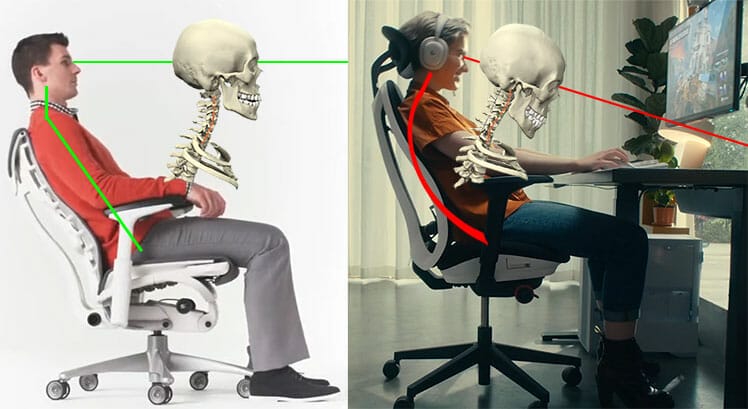
According to GM Jon Campbell, those suckers customers using neutral postures in their Herman Miller chairs will now need ‘retraining’:
To learn more, check out this comparison of the Vantum vs Respawn Flexx (gaming-office chair from the HNI Corporation):
Ergonomics Beyond The Cubicle Era
In 2023, assessing a chair’s potential based on its back support qualities is obtuse for several reasons. First, institutional ergonomists now tout multi-device (back and neck) support as the design priority.
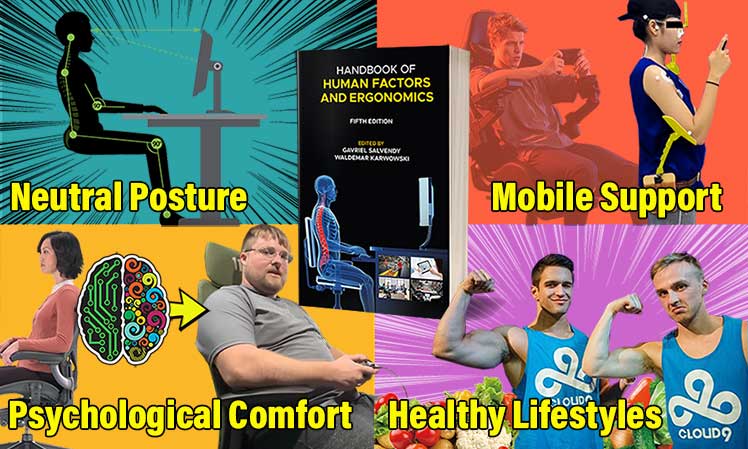
Concurrently, many esports docs are hyping disciplined fitness as greater performance boosters than a chair. As well, top brands like Herman Miller are rushing out new relaxed posture seating concepts.
Meanwhile, new comfort paradigms have emerged. Physiological comfort comes from sitting in neutral postures. But when a chair looks more appealing, studies show that users perceive it as so.

Therefore, the psychological comforts provided by plush upholsteries or fancy designs do make a difference. However, the latest esports intel suggests that user-powered habits are the most important comfort-boosting factor of all.

Frequent breaks, regular exercise, and clean lifestyle habits trump the impact of a chair. With sound habits, any old, ugly beater chair can do the job.
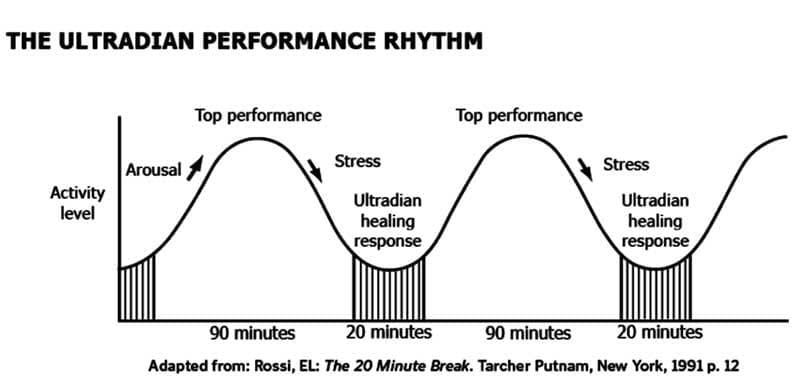
In contrast, healthy lifestyle habits plus a good chair can supercharge your health, happiness, and computing productivity.
2023 Comfort Factors: Physical, Psychological & User-Powered
Related: 2023 Seating Trends: Multi-Device Neutral-ish Posture + Fitness
Recap: Ergo Chair History 1904-2023
Here’s a condensed timeline, with key seating industry moments highlighted:
- 1904: First Adjustable Desk Chair. Frank Lloyd Wright designed the first office chair with a height-adjustable seat.
- 1972: NASA Discovers Neutral Postures NASA scientists discover healthy sitting biomechanics while observing astronauts aboard the Skylab Space Station.
- 1976: Padded Office Chair. Herman Miller’s Ergon chair adds foam and padded arms to a height-adjustable seat.
- 1990s: Personal Computing + Internet. Rising sedentary times skyrockets lower back pain problems worldwide.
- 1994: First Fully-Ergonomic Chair. Herman Miller fuses NASA’s neutral posture tech into the Aeron desk chair.
- 1999: Second Fully-Ergonomic Chair. Steelcase responds to the Aeron with the Leap chair.
- 2005: Neutral Posture Car Seats. Nissan fuses NASA’s neutral posture tech into ergonomic car seats.
- 2006: First Full-Back Gaming Chair. Car seat maker DXRacer borrows Nissan’s car seat tech to create full-back, racing-style gaming chairs.
- 2008: First Ergonomic Computing Chair. Herman Miller’s Embody was released as a more versatile ‘computing’ chair.
- 2013: Steelcase Gesture. Steelcase releases its own ‘computing’ chair.
- 2013-2020: Desktop Computing Ergonomic Science Stalls. NASA’s neutral posture concepts (adjustable lumbar + arms + recline) don’t develop any further.
- 2021: Multi-Device Ergonomics. The Handbook of Human Factors and Ergonomics hypes multi-device support as the new ergonomic priority.
- 2022: Esports Hypes Fitness Over Chairs. Top docs tout frequent breaks and healthy lifestyles as better performance boosters than good sitting posture.
- 2022: Herman Miller Vantum Abandons Good Posture. Herman Miller’s Vantum decrees perfect sitting posture outdated – relaxed postures better fit these times.
- 2023: Seating Priorities Go Beyond The Cubicle. Neutral posture, mobile support, psychological appeal, and user discipline form take over as the ergonomic priorities of our time.
Footnotes
- Lance C. Dalleck, M.S. and Len Kravitz, Ph.D. ‘The History of Fitness’ University of New Mexico, https://www.unm.edu/~lkravitz/Article%20folder/history.html, (accessed 3 Feb. 2022).
- David Yosifon and Peter N. Stearns. ‘The Rise and Fall of American Posture’. American Historical Review (Vol. 103, No. 4 (Oct., 1998), pp. 1057-1095. https://www.jstor.org/stable/2651198, (accessed 13 March 2022).
- ‘Antique Office Interior Photographs ~ 1890-1894 ~’. Early Office Museum. https://www.officemuseum.com/photo_gallery_1890s.htm, (accessed 13 March 2022).
- Ben Sehl. ‘The History of the Modern Office Chair’. January 2019. https://www.branchfurniture.ca/blogs/turn-key/the-history-of-the-modern-office-chair, (accessed 13 March 2022).
- ‘Recaro celebrates 50 Years of the Sportsitz’. Press Release, April 23, 2015. https://www.recaro.com/recaro-group/press/press-releases/recaro-celebrates-50-years-of-the-sportsitz.html, (accessed 8 March 2022).
- ‘A strong name and its history’. Part 1, Part 2 (accessed 8 March 2022).
- NASA Technology. ‘NASA Standards Inform Comfortable Car Seats’, NASA Spinoff, first published in 2013. https://spinoff.nasa.gov/Spinoff2013/t_4.html (accessed 12 March. 2022).
- Clark Malcolm. ‘Creatures of Comfort’, WHY Magazine https://www.hermanmiller.com/en_mde/stories/why-magazine/creatures-of-comfort/, (accessed 13 March 2022).
- Stephanie A. Prince, et al. ‘Sedentary behavior surveillance in Canada: trends, challenges and lessons’, Int J Behav Nutr Phys Act 17, 34 (2020). https://ijbnpa.biomedcentral.com/articles/10.1186/s12966-020-00925-8, (accessed 4 Jan. 2023).
- Aimin Wu, et al. ‘Global low back pain prevalence and years lived with disability from 1990 to 2017’, https://ncbi.nlm.nih.gov/pmc/articles/PMC7186678/, (accessed 4 Jan. 2023).
- ‘Zero Gravity Inspired Car Seat’, Nissan Motor Corporation, April 18, 2014. https://www.nissan-global.com/EN/TECHNOLOGY/OVERVIEW/zero_gravity_inspired_car_seat.html (accessed 12 March. 2022).


